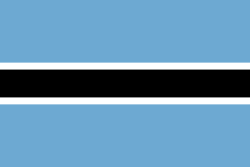| Languages of Botswana | |
|---|---|
 Sign in English and Setswana at the National Botanical Garden of Botswana | |
| Official | English |
| National | Setswana |
| Recognised | Kalanga, Kgalagadi, Shona, Mbukushu, Ndebele, Tshwa, !Xóõ |
| Foreign | Portuguese, Danish, Swahili, German, Afrikaans, French, Arabic |
| Signed | American Sign Language Danish Sign Language German Sign Language [1] [2] |
| Keyboard layout | |
| Part of a series on the |
| Culture of Botswana |
|---|
 |
| People |
| Languages |
| Cuisine |
| Religion |
| Art |
| Literature |
| Music |
| Sport |
The official language of Botswana is English, while Setswana is considered to be a national language. [3] English, which was inherited from colonial rule, is the language of official business and most written communication. Most of the population speak Setswana, but over 20 smaller languages are also spoken. Some of the country's languages are in danger of becoming extinct.

